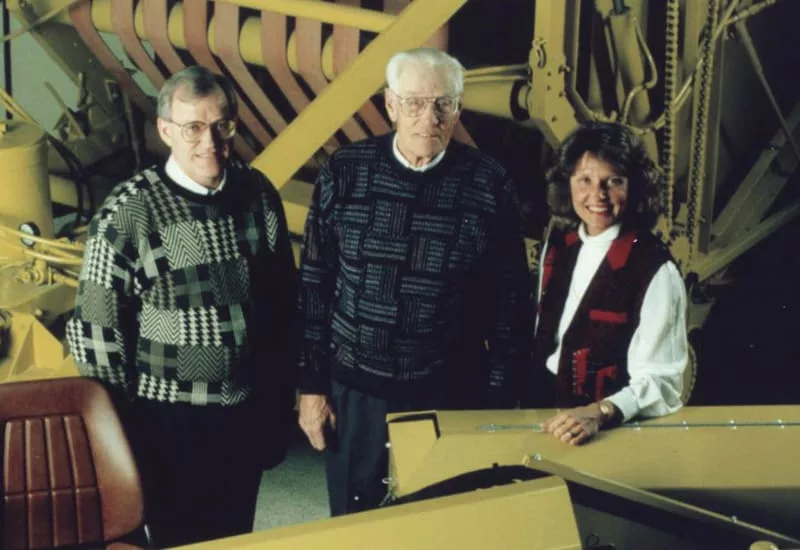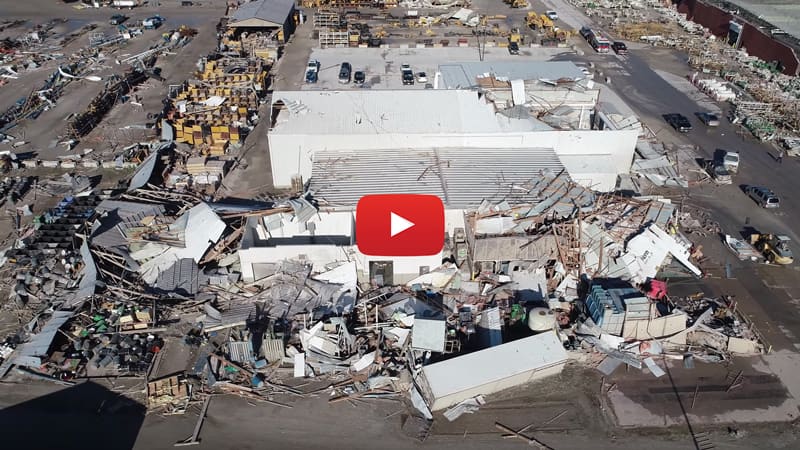Vermeer Corp.’s history of product development has impacted two different industries. In agriculture, it literally revolutionized hay production with the introduction of the first large round baler, the product for which it’s most widely known. Just over a year ago, Vermeer introduced the first self-propelled zero-turn round baler, another product with potential to change the forage industry. Vermeer introduced the first stump cutter, and in the construction field it’s known for pioneering equipment used for trenching and directional boring.
The company has been equally innovative in developing a management structure that has successfully navigated through the challenges of family ownership. Today, multiple heirs to the founder oversee the global company, which employs 3,200 worldwide, including 2,800 at its Pella, Iowa, headquarters. Vermeer’s organizational structure requires family members, who desire employment within the company, to prepare for a leadership role through their education and to work outside of the company before returning to Vermeer.
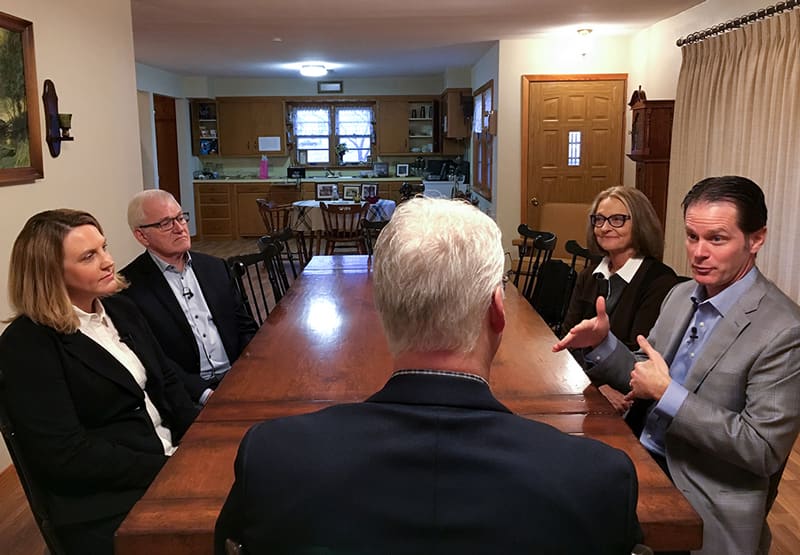
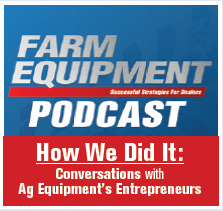
Listen to the full story of Vermeer Corp. as told by 4 generations of the Vermeer family, recorded around the dining room table of the late Gary and Matilda Vermeer, in the “How We Did It: Conversations with Ag Equipment’s Entrepreneurs” podcast series. Visit. www.Farm-Equipment.com/Vermeer
Vermeer has responded to adversity with resiliency rarely seen in large companies. It survived a tornado in July 2018 that wiped out almost 30% of its manufacturing capacity, with only minimal impact on customers and dealers. The ability to weather such a tragedy is largely attributed to the employees, who are encouraged to problem-solve through the use of the Kaizen philosophy of business management.
Origins of Vermeer
The company’s roots go back to when founder Gary Vermeer and his father were picking corn for neighbors during World War II. While trying to quickly get from one farm to another, Gary created a faster way to unload corn with a mechanical wagon hoist. By 1948, other farmers wanted the product so he started his own manufacturing business with cousin, Ralph Vermeer. Gary died in 2009, and today the business is run by a group of Gary’s heirs.
Bob Vermeer, Gary’s son, joined the company in 1974 and became CEO in 1989. Today, he’s Chair Emeritus of the Board of Directors. Mary Vermeer Andringa, Gary’s daughter, joined the business in 1982, becoming president and chief operating officer in 1989 and CEO in 2003. Today, she serves as chair of the board. Third-generation family members Jason Andringa, who became president and CEO in 2015, and Mindi Andringa Vandenbosch, manager of Distribution Development in the Forage Division, are active in the business today.
Mary Andringa describes her father’s background. “He was a farmer, but a ‘tinkerer’ too, and always looking for better ways to do things. He put a cab on a John Deere in 1939 and there was an article in the local paper that showed him in the tractor. It said, ‘When everybody else was on their tractor with purple cheeks and hands because it was so cold, Gary Vermeer was riding nicely along in his cab.’ In those days, nobody had cabs on tractors.’”
Today, 80% of Vermeer’s business is through sales of industrial equipment, which began as PTO-driven tilling trenchers to drain low-lying farm fields, as well as the stump cutter, which was invented to clear land for agriculture. Jason Andringa says, “The heritage of our industrial business actually predates the first round baler, which is the single most iconic invention in Vermeer’s history. But, the business existed 23 years before the invention of the baler.”
Introduction of Round Baler Revolutionizes Hay Business, Spurs Growth for Vermeer
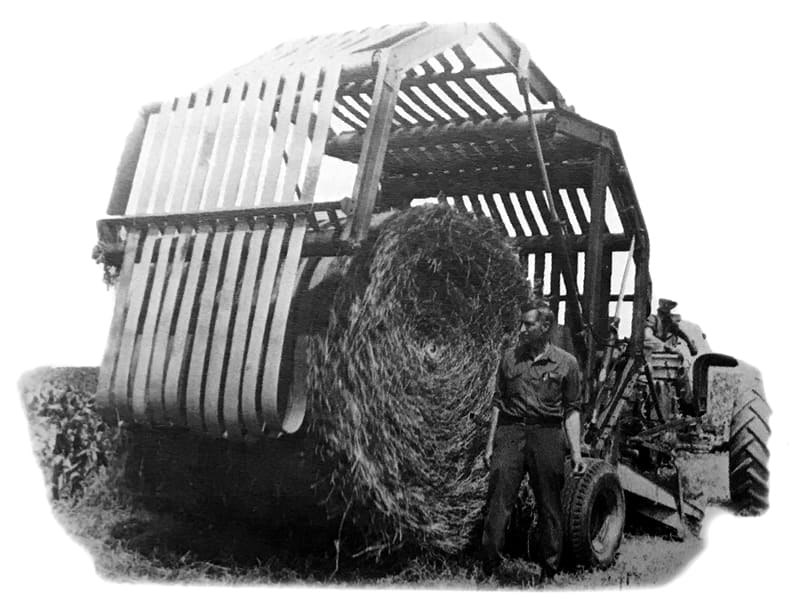
In the agriculture business, Vermeer is best known for its introduction of the first round baler in the early 1970s. Like most of Gary Vermeer’s inventions, the round baler came to be out of trying to find a better way. As the story goes, Vermeer was out walking with his friend and fellow farmer Arnold Van Zee, who shared that he was thinking about selling his cattle because he was tired of putting up hay, explains Bob Vermeer, Gary’s son and now the Chair Emeritus of the Board of Directors at Vermeer.
At the time, putting up hay was at least a 4 person job. “I remember that personally because when I was growing up, we were expected to help in the summer. First you had to rake the hay. Then the actual putting up the square bales, you had someone drive the tractor that made the square bales. Then you had someone on the wagon who was stacking the bales. Then, when that wagon was full, you took that wagon to where the barn was and you took the bales off, put them in an elevator, and they went up in the elevator into the barn, and you had someone in the barn …,” Vermeer recalls.
After that conversation with Van Zee, Gary Vermeer set out to find a better way for his friend and, ultimately, the industry.
“Dad went to engineering with a gentleman called Arnie Mathis, who had a sixth grade education, but he was a brilliant person. And together, they started developing the large round hay baler,” he says.
The first Vermeer round baler formed a bale of hay 6 foot side with a 7 foot diameter, and it weighed more than a ton, according to the book In Search of a Better Way: The Lives and Legacies of Gary and Matilda Vermeer. According to the book, “Gary knew how much time and effort this new round baler could save. Baling itself shrank from a 3-5 man chore to a 1 man operation. The need to shelter the bales was less urgent because the bales were tight, round and shed water. The invention made the entire process easier: harvesting, storing and feeding.”
“And basically, I started at Vermeer in 1974 but the balers started in ‘72. And in the 70s, it’s interesting because I think probably 75% of our sales were from the baler production at that time. So, that was a really exciting time. And you kind of asked about how we financed that. To finance production of the new product line, Vermeer required a $500 deposit on every baler. So that money all came in when the orders were placed, and those were the funds that helped finance, all the production material that was needed for the baler,” Vermeer explains.
Vermeer Corp. had been in business for 23 years before the invention of the round baler. Gary’s experience growing up during the Great Depression always stuck with him, says Jason Andringa, Gary’s grandson and now president and CEO of the company. “The business was always financially conservatively operated. The business had a strong financial foundation to begin with. And then, as Bob said, by expecting a deposit for every order, really it was well-financed for the growth that the baler brought.”
That first year, Vermeer filled 300 orders and all were delivered by May 1972. The very first baler was sold in Guthrie, Iowa, for $3,950 plus freight costs. Following the balers introduction in 1972, Vermeer Mfg. Co. nearly quadrupled in sales by 1974.
He admits that in the late 1970s, if asked what Vermeer made, he would have said “round balers.” A college trip overseas opened his eyes though. “I had the opportunity to visit customers in Russia, who were putting in natural gas infrastructure with machines that came out of our factory. That helped me recognize that Vermeer machinery can make an impact a long way away. Today, the company is a market share leader in horizontal drilling and was one of the first to jump onboard with new technology in that field.”
Mary Andringa says the company has never looked toward merely improving other manufacturers’ designs. “Gary’s premise was to design something new — not on the market. For example, I remember Dad saying, ‘We found this way to be able to dig around a tree, pick it up and transplant it. If you can have a tree in your yard that’s already 10 inches in diameter, wouldn’t that be great?’” Shortly after that, the Vermeer Tree Spade was introduced.
Organization Survives & Thrives Through Disaster
“Friday, July 19 of 2018, we had 400 customers here celebrating our 70th anniversary,” Jason Andringa says, remembering the tornado that wiped out 400,000 square feet of the Pella, Iowa, manufacturing facility. “The performance of the business after the tornado was remarkable.” Miraculously, there were no fatalities; the company had shelters that kept employees and visitors largely safe, but the property damage was immense. Two plants were completely destroyed, as well as what’s called the Vermeer Eco-Center. There were 250 employee cars scattered on top of each other like toys.
To watch Vermeer’s documentary about the events leading up to and following the July 19, 2018 tornado that hit Pella, Iowa, visit www.youtube.com/watch?v=OGuXcQMp87o&feature=youtu.be.
Jason Andringa remembers the aftermath, “The combination of us communicating to our team members and the broad communication the media provided was extremely important to inform our people of what was going on. That evening, we were able to determine that we had no serious injuries; minor injuries had been treated and released and there were no fatalities. The next morning, we came back with our operations leadership team and identified three priorities to assess. First, if there were any of our facilities that could be back in production Monday morning. We wanted to know whether there were facilities damaged that could be repaired and then, what to do with product lines in facilities that were completely destroyed. During that first day, we accomplished all of that.”
On that first day, the operations team determined what space could be freed up in unaffected plants to move the product lines from the damaged buildings. Engineering prototype, tooling efforts and a lot of storage were moved off site. “By doing that, we were able to relocate all of our production lines from destroyed buildings to other locations. We got all of our team back to work within 30 days and recovered production within 45 days. We have heard from our dealers and customers that based on Vermeer’s performance, if they hadn’t heard about the tornado, they would not have known it happened. It likely will be the thing I’m most proud of in my entire career at Vermeer, that we were able to do that,” says Jason Andringa.
“I loved the people, the product and being in manufacturing while seeing our team members hard at work problem-solving. That got me excited. I changed my career path and went into manufacturing. I learned how to weld that summer, building machine shop racks to put jigs and fixtures on…”
— Mindi Vandenbosch
Vermeer’s business philosophy, Mary Andringa says, minimized the tragedy. “It was like a 2 week, mile-long Kaizen, where a lot of leaders took on new roles. The head of our Quality Initiative was in charge of finding space to place prototype machines and one of our legal folks was in charge of dealing with 250 cars that had been piled up on top of each other. Our communication and HR teams were splendid. All of Industrial Engineering helped get lines moved the first month. It was all hands on deck working and reporting back a couple times a day on needs, barriers and how can we help. Since we didn't lose any lives, we'd have to say it was one of our proudest moments.”
Bob Vermeer says, “I think that by going through the tornado, and the tremendous leadership that Jason, Mary and the team gave, we realized how that third generation said, ‘We celebrated 70 years, but we want to go 100.’ I think, ‘Good for you, I may not be around, but God bless you.’ What we went through made us realize how important this company is to our employees and the community. My father Gary would have been very proud of the recovery effort.”

A farmer and tinkerer by nature, Gary Vermeer put a cab on a John Deere tractor in 1939. The local paper ran an article about it with this picture that said, “When everybody else was on their tractor with purple cheeks and hands because it was so cold, Gary Vermeer was riding nicely along in his cab.”
In mid-July of 2019, Vermeer announced it had broken ground on two new facilities. The tornado destroyed Plants 5 and 6, but in the space those facilities use, a new 400,000 square foot facility — Plant 7 — is being built. Two other new facilities they are in the process of building are Shop 48, which will be completed this year, and a new Eco-Center. Vermeer has also begun construction of a new monument on the Vermeer Mile that will remember the tragedy. It will be constructed with pieces from the destroyed buildings and the building numbers will be retired.
“We have heard from our dealers and customers that based on Vermeer's performance, if they hadn't heard about the tornado, they would not have known it happened. It likely will be the thing I'm most proud of in my entire career at Vermeer, that we were able to do that…” — Jason Andringa
With the effects of the storm mostly behind them, the Vermeer family organization is now turning its attention back to developing more new and unique products for agriculture and construction while grooming leadership to take them to the next level. Members of the fourth generation of the family are now entering the age to consider preparation for a job in the family business.
Family & Business
Bob Vermeer remembers the struggles of running a family business. “We went through some difficult times. When we saw the third generation coming along, we decided to look for outside help.”
In 1989, the company employed a Minneapolis family succession planning firm to help develop employment policy. “We went through a whole evaluation process with the third generation. Each family member met with this firm and had to put together a 5-year plan,” Vermeer says. “I remember my youngest daughter, in junior high, couldn’t figure out her plan, but that was valuable. Starting family succession planning was important; there’s a lot of emphasis on communication, rules and regulations, if you want to be involved in the business.
“Three of the third generation were required to get a college degree, work somewhere else, then get an MBA,” Vermeer says, “which set the bar to be part of management in the future. When they worked for another company, we wanted to see them earn a promotion and possibly supervise other people. Then, when they came back, they would be respected by people who worked here with the background they had.

On July 19, 2018, an EF-3 tornado struck Pella, Iowa, causing severe damage to Vermeer’s facilities, completely wiping out 400,000 square feet of the manufacturing facility. Despite the damage, there were no fatalities. In July 2019, the company broke ground on a new manufacturing facility that will be over 400,000 square feet, as well as a new monument, built from some of the debris, commemorating the tragic event.
“Another thing we’ve started recently is shareholder directors on the board,” Vermeer says. “If they want to be a director, they have to go through an evaluation process; we put together a development plan related to areas of strengths and weaknesses. That’s invaluable, because for a period of time, there were some family members on the board and really no requirements. I think we’re in a much better place now, where people have to be approved.”
Mary Andringa says the process involved a system of self-governing. “We have family, the business and shareholders. The shareholders and family aren’t necessarily the same, so a lot of processes had to be developed. We started with a small group called our Family Council, now called the Ownership Council. Mindi is chair of the Ownership Council and she followed Bob’s daughter, who was the first chair. There are a lot of guidelines around that — how you serve, what the roles are and what you have to work on. To be honest with you, the Ownership Council deals with a lot of hard stuff.”
“The whole idea is that we didn’t want entitlement,” says Mary Andringa. “Whether it’s family members in the business or on the board, it’s not that ‘it’s your turn now.’ Jason and Mindi both had to follow the family employment policy requirements.”
Photo Gallery & Video Recap
To view additional photos from the company's history, click here.
To watch a video recap on the company's history, click here.
Mindi Vandenbosch says the process helped her prepare for a career in the family business. “I think the most important thing, in those early discussions, is that there were set expectations. So to the point, I didn’t just show up here to be on the board. Early on — junior high for me — there were expectations of how you needed to get here. If you wanted to put the work in, you could come back to Vermeer. It was really good — defining expectations so we knew what we were getting into vs. being surprised.”
Vandenbosch worked at the company in high school, in the late 90s, and came back the summer before her senior year of college on the factory floor, which she says was defining for her. “I loved the people, the product and being in manufacturing while seeing our team members hard at work problem-solving. That got me excited. I changed my career path and went into manufacturing. I learned how to weld that summer; building machine shop racks to put jigs and fixtures on.”
“It was helpful that we had the family employment policy in place before I went to college,” says Jason Andringa. “I selected my major thinking that it would be a good fit to go back to Vermeer. I was thinking, ‘What would be an interesting thing to do for a period of time before I go back to work for the company?’ I never thought, ‘Maybe I’ll go straight to the company,’ because in my mind, it wasn’t an option.”
Mary Andringa says there’s no pressure for Vermeer descendants to return to the company. “We tried to make a point, and that’s part of the family constitution, that we wanted to support each person wherever their passions were. If they had a true passion and skillset to come to the business, that was great and we had a way to do that. But it was not expected that everybody had to come into the business either, it’s a balance.”
Challenges Can Be Positive
Vermeer has fully embraced the Kaizen philosophy, which comes from the Japanese words “kai-” which means “change” and “-zen” which means “good.” The process involves all areas of the company, not just manufacturing. Under Kaizen, employees are expected to stop their work when they encounter challenges and, along with their supervisor, suggest improvements that lead to resolutions.
Vandenbosch says part of the process involves changing the mindset of employees. “What I found is you have to get your team members excited about making change. Change is hard, but if it makes their day, their job, or their life better, they typically get on board. In a business process, it’s ‘I hate running this report.’ We then look at: do we have to run it or can we run it differently? So it’s challenging them to own change, which encourages the buy-in more. It was a struggle at first, in the 90s, but it’s exciting now, empowering our people to own opportunity.”
Jason Andringa had first-hand experience with the philosophy when he came back to Vermeer. “That first summer, I did a lot of Kaizen work and support. I had previously worked at the NASA Jet Propulsion Laboratory for Robotic Space Exploration. I was at one point rearranging greasy parts setting up our line for brush chippers. I remember thinking to myself, ‘Just a few months ago, I was designing spacecraft.’ I’m glad that’s how we do it at Vermeer, though, that we’re brought into jobs where we can build respect within the organization.”
Vandenbosch agrees, “I loved being on Kaizen events with everyone on the floor, and I typically wore my badge on my jeans so they didn’t know my last name. I loved seeing the realness before they realized Mary’s daughter was out there welding. I feel like everyone treated us with respect, because of the process of the jobs we’ve taken. I don’t feel like there are people telling me something just because of who I am. I appreciate that about the employees.”

